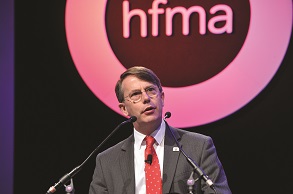News / Warning over activity lag as underspend remains on track
 At the March NHS England board meeting, chief finance officer Paul Baumann (pictured) said the month nine projected underspend was £413m, but at month 10 the forecast had improved to show an underspend of almost £440m in year. Once risks and mitigations were accounted for the figure rose to £478m.
At the March NHS England board meeting, chief finance officer Paul Baumann (pictured) said the month nine projected underspend was £413m, but at month 10 the forecast had improved to show an underspend of almost £440m in year. Once risks and mitigations were accounted for the figure rose to £478m.
‘These are relatively small but welcome movements,’ he said. ‘Equally important is
that the financial performance of CCGs and direct commissioners has been very stable following the in-depth review we undertook at month nine.’
He added that an early look at month 11 figures had shown the performance had continued, with a net £494m underspend after risks and mitigations.
Mr Baumann was confident the year-end position would be an underspend of about £500m. ‘This is critical because it further strengthens our contribution to the strenuous efforts across the whole health economy to offset the position in the provider sector in 2015/16.’
NHS England chief executive Simon Stevens said commissioners received real-terms funding growth of £2bn in 2015/16, with £1bn immediately transferred to the better care fund. NHS England held back £500m ‘as non-recurring but tightly managed underspend’ to help the Department of Health offset rising acute trust overspends. This meant commissioners managed the year ‘with less than £500m extra real terms purchasing power’, said Mr Stevens.
He added that efforts to constrain demand were having some effect but lack of capacity in some specialties, including more complex surgery, meant a ‘bulge’ of activity would be pushed into 2016/17. This could be a big pressure on referral to treatment targets in 2016/17.
Mr Stevens insisted commissioners recognise this in their plans and that providers match this with capacity. If necessary, there must be ‘an upfront discussion about alternatives to enable patients to get timely care’, he added.
Mr Baumann gave a ‘health warning’ on the figures going forward into 2016/17 as much of the £500m potential underspend is non-recurrent. He said roughly £200m came from an underspend in legacy continuing healthcare claims, but these have to be funded over time. The funds set aside for continuing healthcare had been reduced in 2016/17, so there would be less headroom. Similarly, underspends in programme costs also contributed around £200m to the overall underspend, but there will be a 10% reduction in this budget in 2016/17.
The NHS England financial position had also benefited from unplanned rates rebates in 2015/16, but further rebates could not be factored into 2016/17.
Month 10 position
NHS England’s forecast of a year-end underspend of almost £440m includes:
- A forecast CCG overspend of £21m
- Direct commissioning underspend of £65m
- A £373m underspend in programme and running costs
- With technical and ring-fenced adjustments (£23m), the forecast outturn is £439.3m
- Risks and mitigations result in an adjusted forecast underspend of £479m at month 10
- 29 CCGs are forecasting a cumulative deficit, eight unplanned
- Emergency hospital admissions are up by 1.5% – less than commissioners planned for and funded at the beginning of the year
- Elective day cases are up 4.7% but elective inpatients down 1.9% in the year to date. This could push RTT pressures for complex surgery into 2016/17
- Inpatient bed days are ‘flat-to-negative’ despite delayed transfers of care and other flow constraints in the system.
Related content
The Institute’s annual costing conference provides the NHS with the latest developments and guidance in NHS costing.
The value masterclass shares examples of organisations and systems that have pursued a value-driven approach and the results they have achieved.